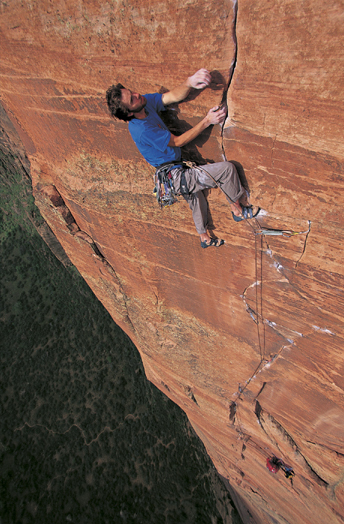For the past two years, I’d dreamed about trying to onsight Moonlight
Buttress, but I knew that I needed to improve my splitter-crack
techniques. With that requirement in mind, I went to Indian Creek. After
a month plagued by bad weather and illness, I was finally starting to
feel comfortable on wide finger cracks–Moonlight has 600 feet of cracks
predominantly this size–so I jumped in my van with my partner Nick
Martino and raced to Zion to beat the hot weather. We’d planned to
attempt the route the next day, but after I fell in the river while
scoping the approach, another rest day seemed in order. The decision
turned out to be a wise one; by the next morning a party was bivying in
the middle of the crux pitch.

Matt Wilder reenacting his first onsight free ascent of Moonlight Buttress (V 5.12+, 11 pitches), Zion National Park, Utah. Nick Martino, who belayed Wilder on his ascent, freed the route in a push two days later. [Photo] Eric Draper
The following day Nick and I hopped the first shuttle up the valley, and
I was soon on route. Perfectly warmed up from the initial four pitches,
I encountered my first significant obstacle just above the
Rocker-Blocker bivy. To gain the 5.11d corner, you have to crank some
challenging crimp moves and a balancy mantel. I found myself hanging
from the slopy mantel jug, smearing bad feet and reaching left to clip a
bolt that would keep me from decking on the ledge below. To my surprise,
the bolt hanger spun as I tried to clip it and my feet began skidding. I
chucked the quickdraw off the cliff so I could catch myself with both
hands on the jug, quickly cranked the mantel and moved onto easier
terrain.
This incident helped me get into the go-for-it mentality I would need
for the next pitch: the 12d crux. As the thin lieback corner became
featureless, about ten feet above my last gear, I blindly placed a small
TCU and glanced at the potential rest fifteen feet above. Before
starting the route, I’d resolved to keep climbing in such situations, so
I motored through to the rest–which turned out to be not as good as I’d
hoped.
Apprehension followed me up the route faster than Nick could jug behind
me. I was able to keep my poise, though, and soon I arrived at the top
of the last 5.12 pitch. Only one 5.10 pitch remained, but I had to
remind myself that it wouldn’t be over until I was standing on the
summit. The final pitch was harder than I expected, but I climbed
through it and reached the top, overjoyed that I had risen to this
route’s spectacular challenge.
Two days later, while I jumared behind him, Nick, who had been on the
route previously, also freed the entire climb without falls.
–Matt Wilder, Weston, Connecticut